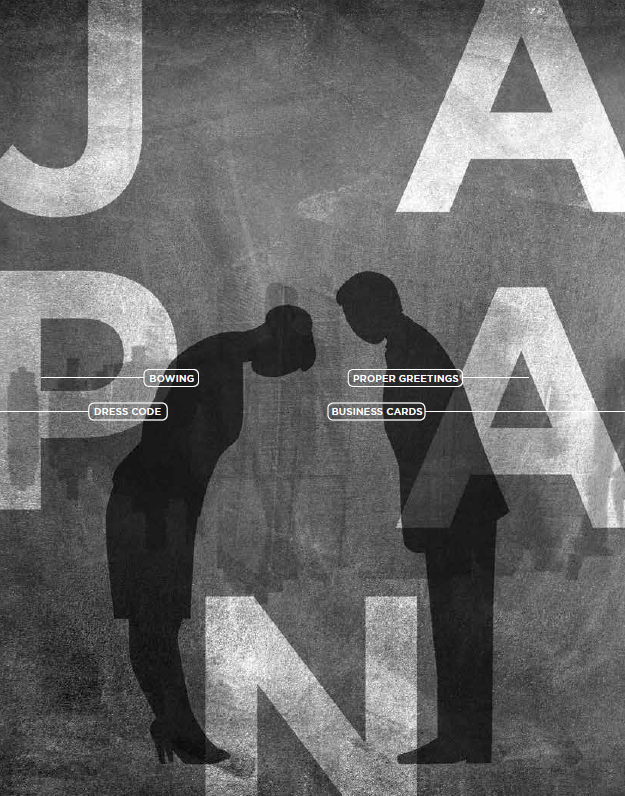
CHEAT SHEET
- Mind your manners. The Japanese pride themselves on manners and consider the code of social conduct to be paramount to the law of the land. When conducting business there, remember to practice the three P’s: politeness, patience, and pragmatism.
- Ringi decision-making. Most Japanese businesses practice ringi, a peer review process. After an employee has presented an idea, equal-ranking employees deliberate on the idea, and a higher-ranking manager makes the final decision.
- The gangster clause. Common in many contracts, this clause thwarts organized crime and is considered nonnegotiable to many Japanese businesspeople. With this law, gang leaders are held criminally and civilly liable for activities and damages caused by gang members.
- Release the Haken. A haken is a temporary employee who is dispatched by recruiting agencies. Japanese employers typically prefer this hiring method, as it’s a flexible yet thorough approach to vet potential candidates and terminate those who don’t fit.
Your manager calls to tell you that you have to fly to Tokyo in two weeks to close a deal with a Japanese company. You are handed the contract for review and analysis. You are excited. This is your first negotiation with a Japanese client; however, you are a little nervous as you only have two weeks’ time to review the contract and learn negotiating tips. You look at the contract and it looks shorter, in terms of pages, than your usual lengthy European contracts. Then you come across an entirely new clause, which you have never seen before. You wonder: What is this “gangster clause”? To add to this, the contract model looks and sounds alien to you. This is different than your usual contracting model. It is a Haken contract, wherein your company is going to treat the employees as Haken employees — temporary employees dispatched to companies by staffing agencies.
The gangster clause
When reviewing a Japanese contract, don’t be alarmed when you come across a gangster clause or antisocial forces clause. Japanese clients consider this clause non-negotiable and do not like deviating from it. Even your gym membership will have one. Anti-Social Forces (ASF), the government’s official term, are groups or individuals that cause damage in order to pursue economic benefit by making full use of violence, force, and fraudulent means. Originally illegal gambling operators, Boryokudan are usually individuals from the lower social caste in Japan. Historically, they were used to quell civil unrest and maintain social order; sometimes through violent means. More recently, businesses have increasingly used the Boryokudan to achieve commercial objectives, such as debt collection, by using its power to intimidate, extort, or to influence decisions. The Boryokudan exists in a unique grey area where, on the one hand, everyone acknowledges that they are significantly involved in organized crime and, on the other hand, they are accepted as part of society. A factor of this acceptance is their charitable and social work. In order to target and control Baryokudan, parallel laws were enacted within the criminal and civil law structure. Following the 1991 economic crisis and Japanese society’s negative reaction against the Boryokudan, organized crime legislation was introduced in Japan for the first time. On February 27, 1992, the National Police Academy of Japan (NPA) published its “Basic Considerations on the Bill Concerning Bōryokudan Countermeasures.” The same year, “Anti-Bōryokudan law” or “Bōtaiho,” Law No. 77 was enacted. A large portion of the Bōtaiho is based on the US Racketeer Influenced and Corrupt Organizations Act of 1970, more commonly known as the US RICO Act. One major similarity between the Bōtaiho and RICO is that the leaders of the group are criminally and civilly liable for activities and damages caused by its members.
No worries; let me prepare you, step-by-step, for your deal with your Japanese client.
This article will discuss three topics: (1) key points that an in-house counsel needs to know when negotiating with Japanese clients; (2) the antisocial forces or gangster clause specific to Japanese contracts; and (3) the Haken contracting model used by Japanese clients.
Key points for negotiation
Doing business in Japan requires an in-depth understanding of Japanese culture. Japan is a perfect example of a country that considers the code of social conduct the paramount law of the land. Willingness to respect the local customs and showing the appropriate consideration and courtesy is a great way to start any business venture in Japan.
Social etiquette: Social conduct in terms of dress code, greetings, and business cards (meishi) have a key role to play when interacting with Japanese clients. Japanese dress code is formal for both men and women. They focus on professional look rather than standing out. Therefore, it is advisable to avoid wearing jewelry, high heels, and short skirts.
Greetings with deeper and longer bows confer greater respect. Exchanging business cards before the start of a meeting is a customary practice in Japan. Unlike in Western countries, the exchange of business cards in Japan takes place before the meeting starts, not at the end. Business cards are expected to be accepted with both hands and with a short bow. Keeping the business card in your pocket, writing notes on it, or not reading it carefully is considered a mark of disrespect. It is a good idea to have two-sided bilingual business cards. If your company is flying you to Japan, it’s likely they can afford bilingual cards. The cards immediately explain your rank in the company’s hierarchy. If you are offered coffee or tea, you should accept. If you reply “no” the meeting will start poorly. Remember to never interrupt the other side (this is true no matter where you do business). People like to hear themselves talk, so let them. They are providing information they deem important.
Business cards are expected to be accepted with both hands and with a short bow. Keeping the business card in your pocket, writing notes on it, or not reading it carefully is considered a mark of disrespect. It is a good idea to have two-sided bilingual business cards. If your company is flying you to Japan, it’s likely they can afford bilingual cards.
Trust as the basis of the business relationship: When it comes to negotiating contracts with Japanese clients, remember that they esteem human relationships and mutual trust. These are the fundamental aspects of the culture, and these characteristics also impact the contract structure. Contracts are considered a symbol of the business relationship. It is not viewed as a tool to legally bind the other contracting party. They prefer simple and concise contracts of fewer than 10 pages, unlike Western clients who prefer a detailed and exhaustive contract. The underlying assumption is that issues can be resolved by mutual consultation if they arise, hence the ever-present “Mutual Consultation” clause found in almost all Japanese contracts.
Group consensus versus individual authority: Japanese clients adhere to their company’s hierarchy and are courteous to their core. They believe in group consensus, rather than individual authority, and are long-term oriented. Consensus-building and long-term orientation require time for discussion and reflection. This is evident from the panel of people who decide positions and rarely makes instant decisions during negotiations. Sometimes, this means the group agrees to do what the boss wants, reflecting the culture’s emphasis on rank.
This consensus decision-making process is referred to as ringi or ringiseido. Ringiseido provides the opportunity for equal-ranking managers or employees of a group within a company to partake in an individual’s idea. The process adheres to the Japanese cultural desire for harmony. The physical action of ringiseido is referred to as the “ringi decision-making process.” It fosters an environment of support and agreement once a higher-ranking manager has reviewed and accepted the recommended decision.
The term “ringi” is a compound word that stems from two suffixes. The first suffix, “rin,” means to submit a proposal to one’s supervisors and receiving their approval, and the second suffix, “gi,” means deliberations and decisions. In most Japanese companies, corporate policy is not clearly defined by the executive leadership. Rather, the managers at all levels below executives raise decisions to a higher level, except for routine decisions. The process of ringi decision-making is conducted through a document called a ringisho. The ringisho is created and circulated by the individual who had the idea. As the ringisho reaches a peer for review, the peer places his or her personal seal (hanko) “right side up” to agree, “upside down” to disagree, and sideways to indicate being undecided. Once all peers have reviewed the ringisho, the manager reviews it and places their hanko on it. The upper-level manager’s decision is final and the ringisho is sent back to the originator who either initiates the idea or re-evaluates, based on the hanko of the manager.
Over 90 percent of all large Japanese companies, including government agencies, follow the ringi decision-making approach. In some companies, ringisho is brought before the executive committee meetings attended by the president, vice presidents, and inside directors where they are freely discussed. This helps resolve differences of opinion.
The 3 P’s: Polite, patient, and pragmatic: A polite, patient, and pragmatic approach is preferred by Japanese clients, rather than a confrontational approach. A collaborative win-win method will help close the contract. Trying to get the upper hand and have the other party to give up more will not work. The pace of negotiation is very slow, considering Japanese clients pay immense attention to detail. Being patient is extremely important when finalizing the deal.
Japanese labor law sets a high threshold for employers to unilaterally terminate a regular employee. But, these thresholds do not apply to dispatch workers because client companies have no employment contract with the dispatch worker.
The haken contracting model
You are now at the final stage of your review process. The contract you are reviewing is a haken contract. Haken is the Japanese term for temporary employees who are dispatched to client companies by staffing agencies. Under this model, the dispatch workers’ employment contracts are entered directly with a staffing company and not with the end-client to whom the haken employees render services. The staffing company dispatches the workers to the client company based on a haken contract between the staffing company and the client company. The client company, rather than the staffing company, directly controls and instructs the workers. Client companies prefer to use dispatch workers because they have greater flexibility to terminate these workers. Japanese labor law sets a high threshold for employers to unilaterally terminate a regular employee. But, these thresholds do not apply to dispatch workers because client companies have no employment contract with the dispatch worker.
The haken law, also known as the Worker Dispatch Act (the Act), was enacted in 1985. The original aim of the Act was to regulate the extra-legal system of subcontractor personnel dispatching that had become commonplace in the automobile and electronics industries. It was designed to allow project-based work and temporary staffing in sectors plagued by a shortage of highly skilled workers, such as software specialists. The Act limited temporary staffing to a “white list” of 13 occupations but subsequent revisions steadily expanded it. Worker dispatching is prohibited for port transport services and construction work.
The 1999 revision to the Act replaced the “white list” with a short “black list” of occupations where temporary staffing remained restricted. This had the effect of opening most of the labor market to the temporary staffing industry. Finally, the 2004 revision removed most of the remaining restrictions on temporary staffing in the manufacturing sector.
Essential contents of a haken contract:
The Act under Article 26 lays down the essential contents of a haken contract. A haken contract should specifically cover the following aspects:
- Scope of work of a haken employee;
- Name and location of place of business where the haken employee will work;
- Period of dispatch of such haken employee;
- Hours of starting and ending the dispatch work and the time of rest breaks in such work;
- Matters relating to who will supervise or give directions to such haken employee on behalf of the end client company;
- Matters relating to safety and health of the haken employees;
- Matters related to handling of complaints submitted by such haken employees to the end client company;
- Matters relating to measures necessary for ensuring the employment security of the dispatched workers to be taken at the time of termination of the haken contract; and,
- Such other matters as may be specified by an Ordinance of the Ministry of Health, Labour, and Welfare.
Key obligations under the Act: The Act outlines certain obligations on persons/entities/business operators who send their employees to clients under haken contracts and entities (end client companies) who engage such haken workers. As per Article 5 of the Act, any person who intends to carry out a “General Worker Dispatching Undertaking” shall obtain a license from the Minister of Health, Labour, and Welfare of Japan. This requires submitting a written application stating basic information about the location of the Worker Dispatching Undertaking, the applicant’s name, and his or her address. The license is valid for three years from date of issuance. The license can be revoked with immediate effect in case any provision of the Act is violated or any condition of the license. In the event that the licensee intends to discontinue the general dispatching undertaking, the licensee is required to notify without delay to the Minister of Health, Labor, and Welfare. A dispatching business operator shall promote the welfare of dispatched workers by taking necessary measures to secure employment, education, and training opportunities, meeting each worker’s wishes and abilities, and to improve their working conditions and otherwise to stabilize their employment. The end client is required to take appropriate measures to ensure that there is no violation of haken contract. They may be required to offer the dispatched worker a permanent position after a certain period of time and when certain conditions have been fulfilled.
The Act initially limited the haken workers’ placement term to a maximum of three years if the dispatch worker’s job did not fit in one of the identified 26 areas. The reasoning was that the identified 26 special job categories required skill and experience and were considered to be professional categories, and therefore there was little risk of replacing lifetime employees with dispatch workers under this category. Further, the placement term of three years was complicated. The term was calculated on a position basis. In other words, if a dispatch worker worked for two years and was replaced by another dispatch worker for the third year, the three-year term would be considered completed and the client company could no longer use dispatch workers for that position.
Amendments to the Act: The Act has undergone many amendments since its enactment in 1985 to improve the working conditions of dispatch workers and to provide stable employment. The 1999 revision to the Act replaced the “white list” with a short “black list” of occupations where temporary staffing remained restricted. This had the effect of opening most of the labor market to the temporary staffing industry. Finally, the 2004 revision removed most of the remaining restrictions on temporary staffing in the manufacturing sector. The result was an enormous expansion of temporary labor in the Japanese labor market.
Between 2000 and 2007, the number of regular employees in Japan declined by about 1.9 million, while the number of non-regular workers increased by about 4.5 million. By 2008, short-term contract and temporary staffing workers had increased from a small percentage to more than 30 percent of the Japanese labor force. The information technology industry employs the highest percentage of dispatch workers (26.9 percent) while the finance industry employs the second highest percentage (19.1 percent). Not surprisingly, the larger employers in Japan tend to have more dispatch workers than smaller employers. In fact, 80.5 percent of employers with at least 1,000 employees use dispatch workers.
The latest amendment to the Act, which came into effect on September 11, 2015, is called the Amendment Act for Securing the Proper Operation of Worker Dispatching Undertakings and Improved Working Conditions for Dispatched Workers. The 2015 amendment abolished the “26 special job categories,” for which there had previously been no restrictions on the period for which a haken worker could be dispatched. It also introduced new common rules governing the dispatch period that apply regardless of the job category.
A three-year limit per dispatched worker per company division was introduced by the 2015 amendment. This means a dispatched worker can only be retained in the same company division for a maximum of three years. After that, the end-client company must either offer direct employment to the dispatched worker, engage the dispatched worker in another company division, or if the end-client company is replacing the dispatched worker with another dispatched worker in the same division, it must make efforts to provide employment opportunities to the original dispatched worker before replacing him or her.
Further, if the end-client company accepts a dispatched worker, knowing that the arrangement is in serious breach of the Act, it will be deemed to have offered the dispatched worker a direct employment contract. In other words, the end-client company will be deemed to have hired the dispatch worker directly and will lose the previously enjoyed flexibility of terminating the employment of haken workers. Any non-compliance of the provisions of the Act and 2015 amendment by the end-client company shall be considered a serious breach of the Act, and the end-client company shall be subject to administrative orders and fines.
Good luck
With all the above information, you, as in-house counsel, are fully prepared to close your upcoming deal with the Japanese company. Ensure that you show due respect to their social culture and observe some of their social etiquettes. Japanese clients are very polite, patient, and prefer simple language, rather than complicated legal terms and concise contract documentation. Be prepared and thorough with proper reasons and justifications for your contract positions, as Japanese clients believe in “need to know” rather than “nice to know.” Most importantly, remember that proper cultural observation opens doors to successful communication and business deals. As the Persian poet Moslih Eddin Saadi said, “A traveler without observation is like a bird without wings.”
Ensure that you show due respect to their social culture and observe some of their social etiquettes. Japanese clients are very polite, patient, and prefer simple language, rather than complicated legal terms and concise contract documentation.
Further Reading
Articles 4, 10, 14, 13, 30, 90, 40-3 of the Act.
The Act initially limited the haken workers’ placement term to a maximum of three years if the dispatch worker’s job did not fit in one of the identified 26 areas, which include: 1) design, creation, development or maintenance of computer system or programs; 2) design of gadgets or appliances or devices; 3) operation of broadcasting equipment; 4) production of broadcast program; 5) operation of computers, telex, typewriters and other office equipment; 6) translation or interpretation; 7) secretaries to managerial or supervisory employees; 8) classification or filing of documents; 9) marketing research; 10) preparation of financial statements or profit and loss statements; 11) preparation of documents required for imports and exports; 12) demonstration or explanation regarding computers, automobiles and other gadgets; 13) tour conducting work; 14) cleaning of buildings; 15) operation or maintenance of building equipment; 16) receptionist; 17) R&D; 18) planning and establishment of business; 19) creation and editing of books; 20) design and planning of advertisement; 21) interior coordinators; 22) newscasters; 23) computer application instructor; 24) sales via telemarketing; 25) sales of engineering or financial products; and 26) production of stage set in broadcasting.
ACC EXTRAS ON… Doing business in Japan
ACC Docket
A Statistical Analysis on Development of the In-house Practice in Japan (Aug. 2017).
Learn Your World – Japan (July 2015).
Development of In-house Practice in Japan – A Chronological Observation (June 2014).
Practical Advise for Effective E-Discovery in Japan (Feb. 2014).
Leading Practices Profile
Resource Library
Guide to Doing Business: Japan (Oct. 2016).
ACC HAS MORE MATERIAL ON THIS SUBJECT ON OUR WEBSITE. VISIT WWW.ACC.COM, WHERE YOU CAN BROWSE OUR RESOURCES BY PRACTICE AREA OR SEARCH BY KEYWORD.




